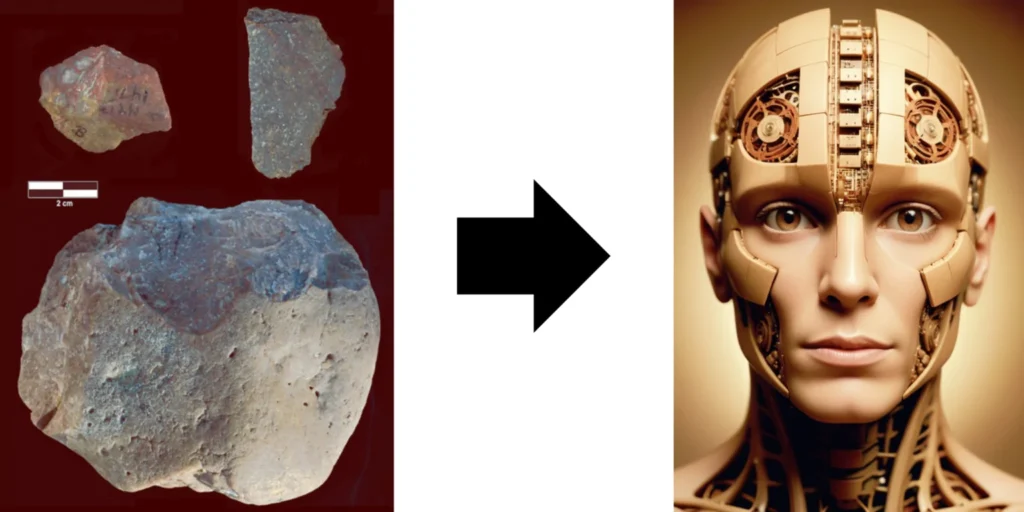From as early as 3.3 million years ago, the spark of innovation has been a hallmark of intelligent life on Earth and our journey to becoming human. From a time when our forebears reshaped stones to make tools to the height of our current digital age, innovation in technology has brought us back from the brink of extinction and propelled us to be the dominant species on our planet.
Contributor: Daniel Lancefield
The first innovations were made not by human beings, but by our proto human ancestors.
Evidence of stone tool use exists in the archaeological record from as early as 3.3m years ago. The first widespread stone tool industry, Oldowan, is associated with Australopithecines garhi, Homo habilis and Homo ergaster in Eastern Africa ranging from 2.9 to 1.7 million years ago. Their ability to create stone tools, and share this skill with others, diverged their path from all other animals and set them on a journey of unique evolution. Implements used to chop, scrape and hammer became a mainstay of early hominid society, allowing the user to efficiently butcher prey, process wood and other materials, and access more energy dense food sources.
Developments in stone tools exemplified the evolution of hominids for millions of years, giving rise to new and complex behaviours and abilities.
The next significant breakthrough in ingenuity would come with the capacity to harness fire beginning as early as 800,000 years ago. Fire, like stone tools, allowed our ancestors to access a greater diversity of food sources, but also made it possible to travel further at night, keep warm in adverse conditions, and ward off predators.
The long evolution of hominid behaviour is revealed in the archaeological record through evidence of complex activity such as hunting and trapping strategies, burial of the dead, rudimentary art and bodily adornments, and animal domestication.
The advent of agriculture around 12,000 years ago enabled humans to forego itinerant hunting and gathering, in favour of more permanent settlements and the eventual rise of civilisations.
The Ziggurat at Ur is one of the last great vestiges of the Sumer, the earliest civilisation in the Middle East.

The Ziggurat of Ur is a 4,100-year-old massive, tiered shrine lined with giant staircases (Credit: Geena Truman)
The Sumerians inhabited the region known as Mesopotamia (modern-day southern Iraq) where ambition, success, and pre-eminence fuelled their innovative spirit. They became masters of building, writing and industry, creating many of the technological wonders that would help to shape the ancient world. Their use of clay tablets for writing demonstrates the earliest evidence of recording information.

Early writing tablet recording the allocation of beer, 3100–3000 BCE, Late Prehistoric period, clay, probably from southern Iraq. (Credit Trustees of the British Museum)
They made ingenious use of materials such as clay – the plastic of the ancient world – for everything from bricks and pottery to writing tablets and even children’s toys. They introduced the pottery wheel for the mass production of containers and by 3000 BCE developed the first writing system on clay tablets for inventory tracking and trade. Their legacy laid the groundwork for modern civilization, influencing how we cultivate food, construct buildings, and communicate.
Ancient Roman civil engineering advancements developed from around 300 BCE in infrastructure including aqueducts, roads, and complex architecture all heralded a new age of sophistication, and greater scientific understanding.
Flashing forward, the wonders of the industrial revolution from 1760 to 1840 brought discoveries of steam power, electricity, the early telephone, and internal combustion engines.
In the last century alone, the rise of computers, television, wireless communication, and the internet, have reshaped our world into one of global connection and knowledge sharing.
The most nascent innovations from this century are undoubtedly in the realm of energy generation and artificial intelligence.
While humans have long made use of water wheels, windmills, heliostats and other technology that makes use of natural resources, we are now enjoying the relatively new take on old classics with advanced solar, wind and hydro energy production.
Likewise, while artificial intelligence once dwelled exclusively in the realm of science fiction, we are now living through the most groundbreaking innovation of our new information age.

Photo by Armin Rimoldi
To say that our adventure of innovation has come a long way is an understatement of the highest order of hyperbole. It took us three million years to go from a stone fashioned into a crude blade to being able to order a pizza using a hand-held device with more power than all of the greatest supercomputers from the 20th century.
The true essence of innovation relies on our ability to look at things not just as they are, but as they could be.
We innovate when we explore what is possible, with a hopefulness for the world we know, to be better tomorrow. Each passing day yields countless stories of ingenuity, perseverance, and the human desire to push boundaries. Our adventure is far from over.
Contributor: Daniel Lancefield : attained a BA (Archaeology) from the La Trobe University, Melbourne, Australia; a passionate advocate and facilitator of building a better tomorrow to abate climate change and environmental catastrophes.















